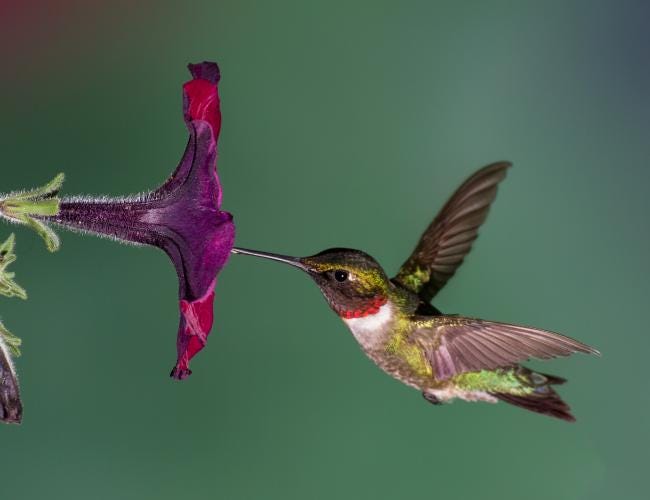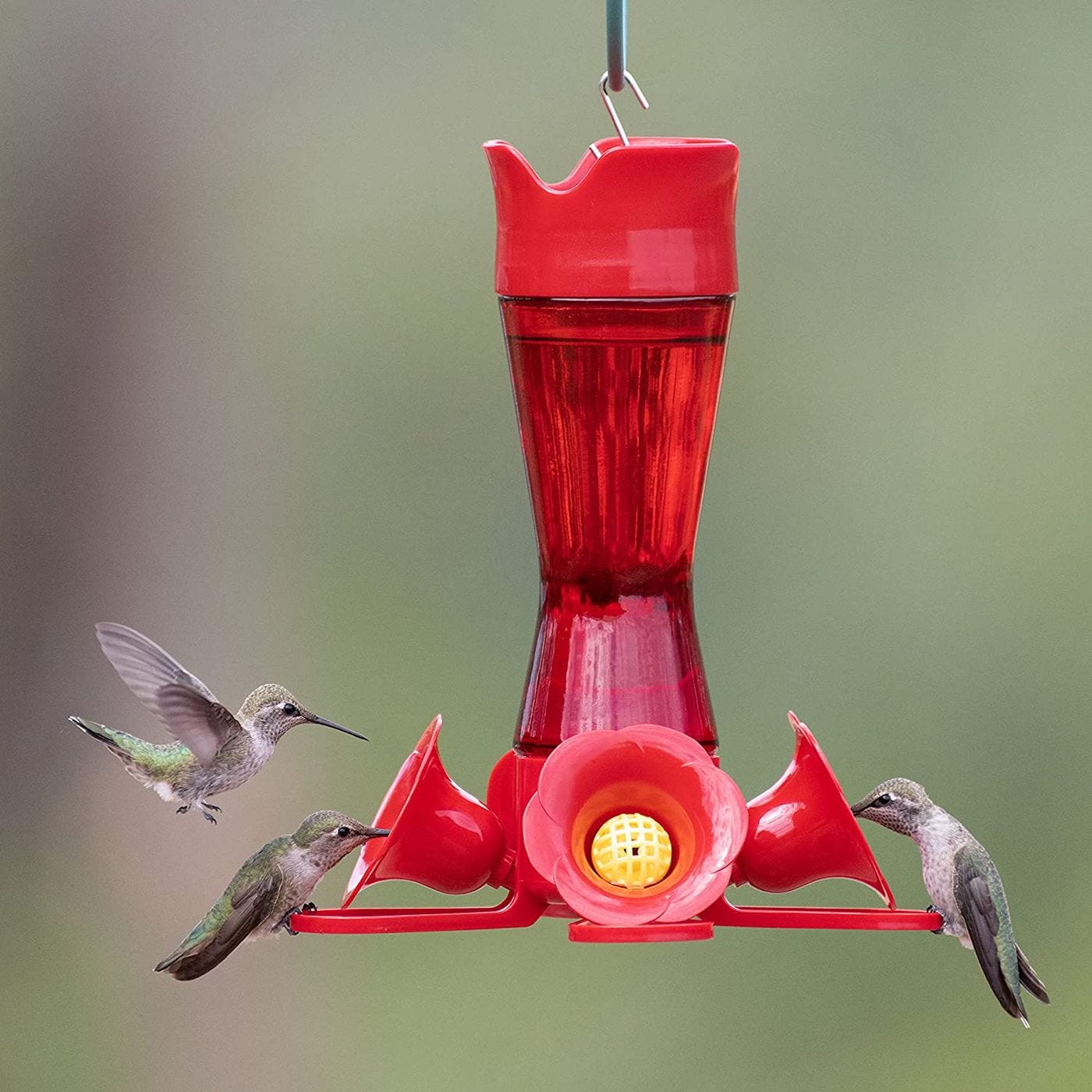Welcome to Natural Wonders, where I hope to pique your interest each week by sharing some fascinating questions and answers about natural phenomena. If you’re new here or if someone forwarded you this email, you can subscribe below.
Check out past posts by going here and see who I am and what Natural Wonders is about here.

The hummingbirds are back!
For those of you receiving this newsletter outside of North or South America, hummingbirds are extremely tiny, iridescent birds about the size of a large bee that feed almost exclusively on the nectar of flowers. They get their name from the humming sound their lightning-fast wings make as they dart and dive about. Each spring they arrive in the U.S. from having migrated somewhere south for the winter, and they stay until early fall.
We have a hummingbird feeder filled with sugar water that hangs on our back porch, and every year around my birthday at the end of March they begin to arrive. We only have about four birds stay each year. They take turns drinking from the feeder and chasing each other off as they rotate individual ownership of the nectar.
For the past few years, whenever the feeder gets low or runs out, I’ll be notified by a hummingbird hovering directly outside whichever window I happen to be near. They’ve trained me, as reliably as Pavlov’s dogs, to change the feeder whenever I see them hover beside me.
At first, I just complied by filling the feeder but the more I thought about it the more impressed and curious I became. First, does this mean the birds have realized the feeder doesn’t just magically fill itself, but that I’m the Master of the Feeder? That in itself is pretty impressive. But then I realized – their “communication” with me has been happening for several years in a row. That’s when I began to wonder:
Are the same hummingbirds returning to my house each year?

First, a few amazing facts I learned about hummingbirds when I dove into answering this question:
There are 340 different species of hummingbirds, but all of them only live in North or South America.
The only species east of the Mississippi River is the ruby-throated hummingbird, the variety that frequent my feeder.
Hummingbirds weigh 2-20 grams, about the weight of 10 paperclips.
Their nests are about the size of a walnut and made of plant material and spider webs. Their eggs are the size of peas.

Hummingbirds are also amazing flyers. They are the only vertebrate that can hover for sustained periods of time – this is because they’re able to power themselves on both the downward and upward stroke of each wingbeat. This allows them to hang still in midair as they drink nectar from downward-facing flowers, flying backwards and even upside down if need be. Their wings beat up to 200 times per second when diving, which in turn means they have an exceptionally high heartrate of 1200 beats per minute. Their highspeed life means they must eat almost constantly and have extremely high metabolisms.

Their constant need for food – they must eat at least every 15 minutes – means they’re very competitive. Anyone who has hung a hummingbird feeder knows these birds to be feisty and aggressive towards each other. They are protective of their food sources, to the point of chasing off competitors at the slightest provocation. I’ve had to sit very still on my back porch as they fight for the feeder, hoping I won’t end up being impaled in the head by an errant highspeed dive-bomber (they’ve been clocked at 45mph during courtship rituals). Their competitive nature means hummingbirds don’t live or work together in flocks and they don’t mate for life, like many other more community-oriented birds.
So, if they have to eat several times an hour, how do they survive all night without eating? Hummingbirds go into torpor, a very deep sleep much like hibernation, in order to survive overnight and during other periods without food. But they obviously can’t survive all winter without food, so once the weather gets colder and blooming flowers begin to disappear, hummingbirds head to southern Mexico and Central America for the winter. As they migrate, they make stops along the way to fuel up at gardens and backyard feeders to build up their fat reserves. But when they reach the Gulf of Mexico, they have to make the full 500 miles in just one push without eating. Somehow, they fly the distance in about 18-20 hours, less than a day. One hummingbird myth is that they don’t actually make the entire journey themselves, but hitch a ride on the backs of other migratory birds. That, needless to say, has been disproven.

Considering this enormous distance, it was amazing for me to find out that hummingbird DO return to the same nesting grounds each year, oftentimes arriving on the same exact day, year after year. Scientists know this from tracking them with tiny aluminum bands around their legs (they’re way too small to outfit with transmitters that would track their flight). This means my hummingbirds, those brilliant little human-trainers, are the same ones year after year. Or at least for 3-4 years, which is their typical lifespan, though some have been known to live up to 9 years.
How do they know how to get back to the same exact place on the same exact date? Hummingbirds aren’t nearly as intelligent as Crows, and their brains are miniscule – the size of a grain of rice. Scientists aren’t exactly sure how they do it, but some theories include:
They may be able to sense the Earth’s magnetic field to orient themselves. I’ve written before about our bodies’ ability to produce magnetite (it’s one reason MRIs work on us – the M is for Magnetic). Many migrating birds are able to navigate because of small deposits of magnetite in their beaks that help them locate due north.
Scientists think the birds’ pineal gland, which is located on the tops of their heads, is sensitive to light and helps with direction-finding. They may use the position of the sun like a compass to determine locations.
They may use their senses of hearing and smell to navigate back to the same place each year.
Like beech trees that don’t put out new leaves until the day has lengthened to around 13 hours long, hummingbirds may use the increasing amount of sunlight during spring days to know when it’s time to leave.
Now that I know these tiny bejeweled dive-bombers are the same exact ones I’ve been seeing for the past few years, I have newfound motivation to hop to it when they insist I refill the feeder. After all, they’ve worked really hard to get here.
If you’d like to attract more hummingbirds to your yard, try this:
Hang a feeder with a sugar-water nectar you can easily make at home. DO NOT add red food coloring – the red of the feeder itself is enough to attract them, and the artificial coloring may be harmful.
Clean your feeder regularly – I’ll admit I need to do this more often. Bacteria can form and the sugar water can ferment (we don’t want tipsy dive-bombers attempting to navigate around us).
Plant flowers in your garden with a high nectar content. They tend to favor flowers that are red, orange, purple or pink.
If you want to get up close and personal, try out one of the hummingbird feeder helmets for sale online (though this one might be homemade):

Photo from Reddit
Do you have hummingbirds visit your home? Any little quirks that made you think they might be the same birds that visit every year? What have you noticed about them? Share in the comments below!
Nature break: If you have hummingbirds that live near you, try getting as close to the feeder as they’ll let you and watch them. Can you see their tiny feet? (One myth about hummers is that they don’t even have feet!) Can you tell the difference between the showy males and more camouflaged females? What behaviors do you notice?
Weird Nature of the Week

Detritus
The U.S. Pentagon is developing hummingbird drones - tiny 6.5 inch remote-controlled airplanes that could be used for search and rescue but also for spying. This feels like just the first step to Michael Crichton’s Prey becoming a reality…
If you love storms as much as I do, you’ll love checking out the winners of the World’s Best Storm Photography.
Pink Floyd is on the lam!
Welcome to all of our new subscribers! If you enjoyed this issue, please click the “like” button below - it helps raise the profile of the newsletter and makes it easier for others to find it. And please share it with your friends!





Fascinating!!
Wow! I hope to see a hummingbird one day. We don't have them in New Zealand (plenty of amazing birds but sadly not hummingbirds)